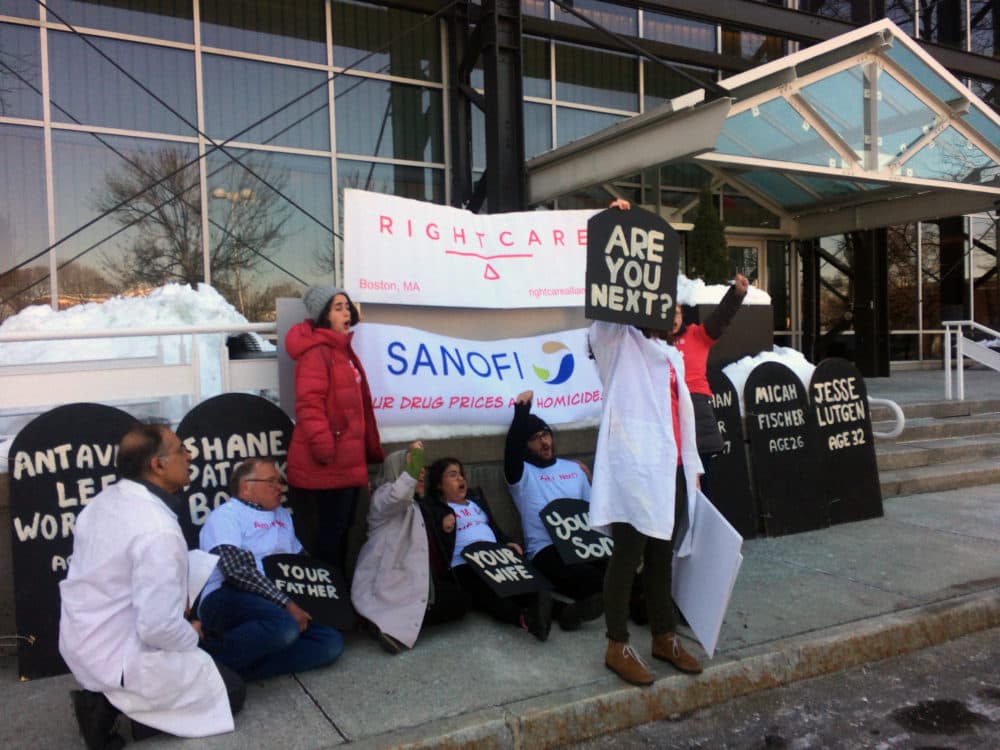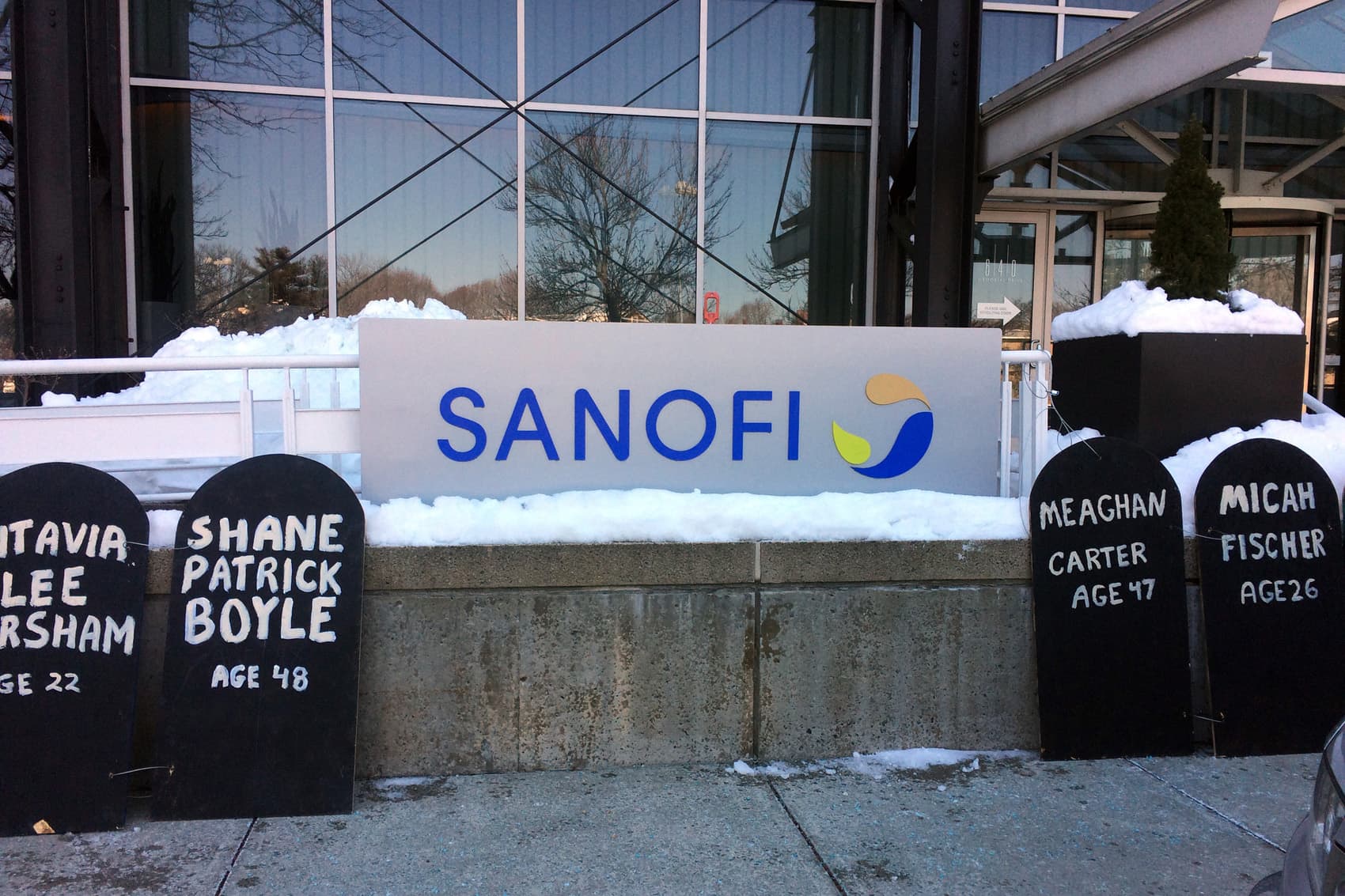Advertisement
Activists Demand Plan From Drugmaker Sanofi To Lower 'Pressing' Insulin Prices

Seven million Americans take insulin every day to stay alive. The drug was first developed almost a century ago. But for the past couple of decades, the price of insulin has gone through the roof.
It’s become so expensive, almost 25 percent of people who take insulin have had to ration the drug. Some of them are dying.
How did it get this way? How did such a vital, well-known, long-developed drug get so far out of reach for so many Americans — especially when that exact same drug can cost one-tenth of the price in other countries?
Pharma execs were hauled before a congressional committee last week to give their view. Drugmaker Eli Lilly says it will cut the price for a version of its insulin in half.
But there’s a deeper problem here, one that will take myriad solutions.
To that end, activists are confronting the insulin problem in a very public way.
Tuesday, outside of the Cambridge, Massachusetts, offices of Sanofi — one of the three drugmakers that control 99 percent of the global insulin market — a small group of 10 protesters stood in front of makeshift tombstones. The tombstones were tall, painted in black, with white letters of the names of people who have died because they couldn’t get insulin.
One of the names is Meaghan Carter.
"Meaghan had just gotten a new insurance. And she was in between jobs, got her new job, got her new insurance, and was days away from the insurance kicking in when she died," said Stephanie Aines, with the Right Care Alliance, a medical activist group.

The average price of insulin has nearly tripled in a 10-year period. Patients with insurance might have to pay as much as $300 for a single vial of insulin that lasts just a week or two.
Sanofi says it has programs to help patients reduce out of pocket expenses. But protester Chris Noble, wearing a shirt emblazoned with the words, "Am I Next?" says it’s not enough. He says saw how precious insulin was back when he was teenager at a camp for diabetic kids.
"A lot of my counselors were dependent upon those camps to get the donated insulin that was supplied to them," Noble said. "And so that was their health insurance, was going to these camps, working there over the summer, desperately hoarding as much insulin and medical supplies as they could until the next camp session."
Protesters like Noble and Aines eventually tried to enter the Sanofi building. They ask to meet with a Sanofi executive. Security guards threatened to call the police, so they left.
Advertisement
Back outside, 70-year-old Martin Drilling, who’s had Type 1 diabetes for more than 60 years, says the solution won’t come from pharma companies alone. He had a message for Congress.
"I would just emphasize the point that in the richest country in the world, we should not be discarding our humans and citizens so companies can make more money," Drilling said. "It is incomprehensible to me that they have not come up with a plan to address this pressing need."
Statements From Insulin Manufacturers Eli Lilly, Sanofi And Novo Nordisk
Eli Lilly
We want to provide help for people who need it while not disrupting access for the thousands of Humalog patients who pay lower prices because of their insurance designs. The significant rebates we pay on insulins do not directly benefit all patients, and this needs to change. For people with diabetes, a lower-priced insulin can serve as a bridge that addresses gaps in the system until a more sustainable model is achieved.
The current healthcare system operates on a high list price/high rebate model. Cutting the list prices would significantly disrupt the healthcare system for patients. Approximately 95 percent of people who use Humalog pay less than $100 for their monthly prescription because of their insurance design and or cost-savings programs. Lilly Insulin Lispro is a less disruptive approach to reducing list prices that still provides an answer for people who need help.
Sanofi
Since 2012, the net price of Sanofi insulins has declined by 25 percent, yet patient out-of-pocket costs has continued to rise. Take Lantus, for example, our most prescribed insulin. The net price has fallen over 30 percent since 2012. Over this very same period, average out-of-pocket costs for patients with commercial insurance and Medicare has risen approximately 60 percent.
Lastly, it’s important to note that Sanofi has implemented new innovative programs to ensure individuals without insurance or those without adequate insurance have access to our medicines. The most notable is our Insulins Valyou Savings Program, which sets a fixed, deeply discounted price ($99 for each 10 mL vial or $149 for each box of pens) to help lower out-of-pocket costs for Sanofi insulins (Lantus, Toujeo, Admelog, and Apidra). For some patients with diabetes, the program could offer a savings of up to $3,000 per year.
Again we really insist on the following for your coverage: anyone who is prescribed a Sanofi medicine, and who may be having financial challenges or trouble navigating their insurance, please call (800) 633-1610 where eligible patients can be connected to the resources they need at no cost.
Novo Nordisk
We know a growing number of Americans with diabetes struggle to pay for their healthcare, and this can include paying for medicines we make.
One of the reasons for the disparity between list prices and net prices is the demand by payers for higher rebates. These increasing demands for rebates from payers allow Novo Nordisk to maintain and expand the availability of its medicines on formularies – the lists of medicines health plans cover – and ensure that patients have access. However, Novo Nordisk has no ability to control whether the rebates it pays to enable broader access to medicines result in lower out-of-pocket costs. What a patient pays at the pharmacy counter is also influenced by how one’s insurance plan is designed, which causes those in high-deductible health plans to pay list prices.
We’ve provided several offerings for some time to support people who have difficulty affording their insulin, including:
- Human insulin – the type of insulin used to establish the current diabetes standards of care – can be found at many national pharmacy chains for $25/vial. This has been used effectively to lower blood glucose for decades by millions of Americans and people around the world
- Co-pay cards to help defray the costs of those who are experiencing high out-of-pocket costs driven by list price, and
- A patient assistance program that, in 2018, provided free medicines to tens of thousands of people with diabetes who didn’t have health insurance
Because people are looking to us to continue innovating against this serious disease, we remain committed to identifying additional solutions to address access and affordability. It will require efforts from all parties in the US health care system to solve this challenge, and we want to be part of the solution.Ultimately, any solution has to make buying medicines easier for patients, and effectively work within the broader healthcare system.
Editor's Note: A previous version of this story misidentified Chris Noble. We regret the error.
Alex Schroeder adapted this interview for the web.
This article was originally published on March 06, 2019.

